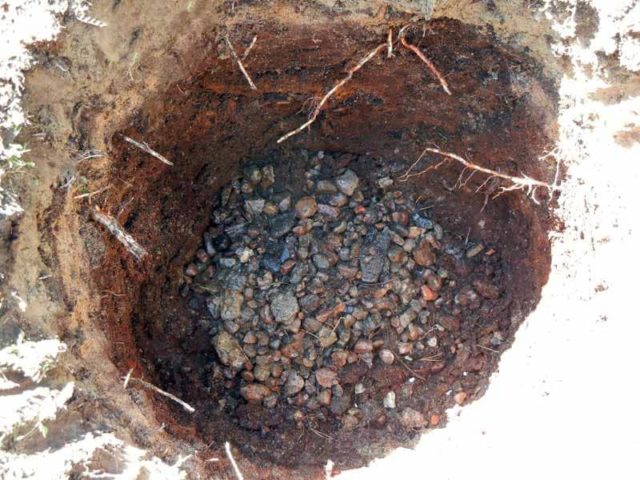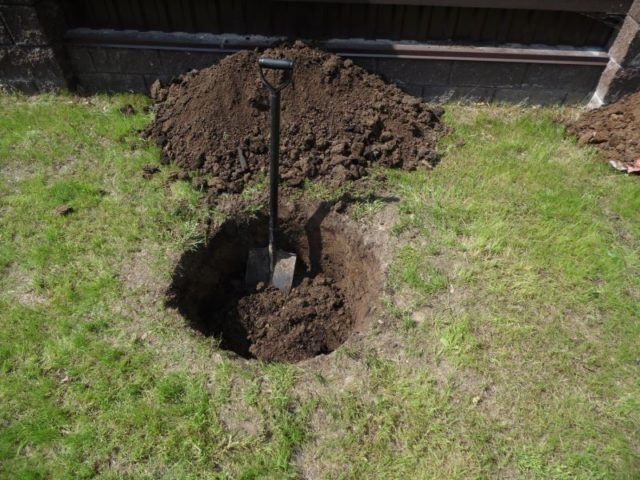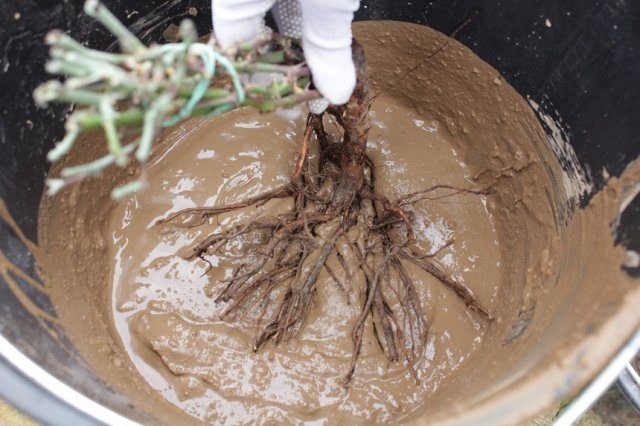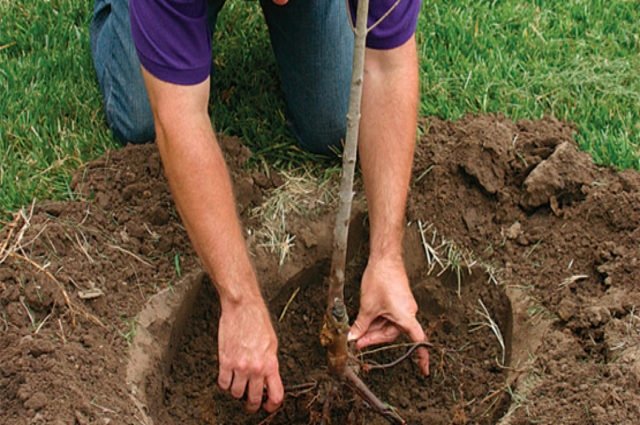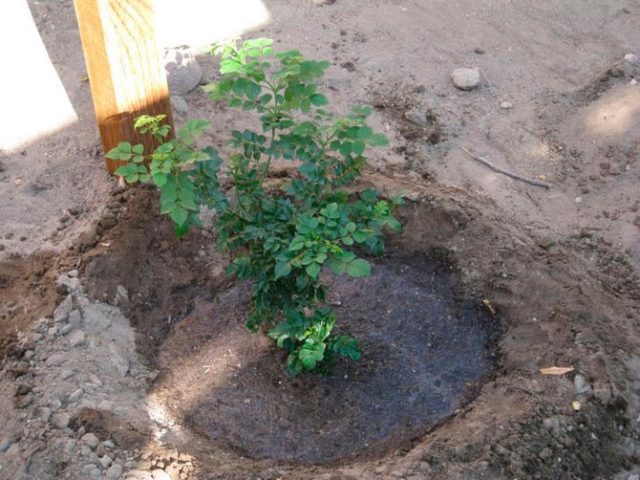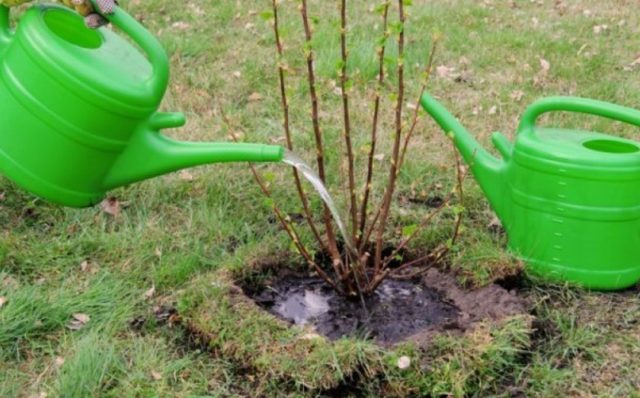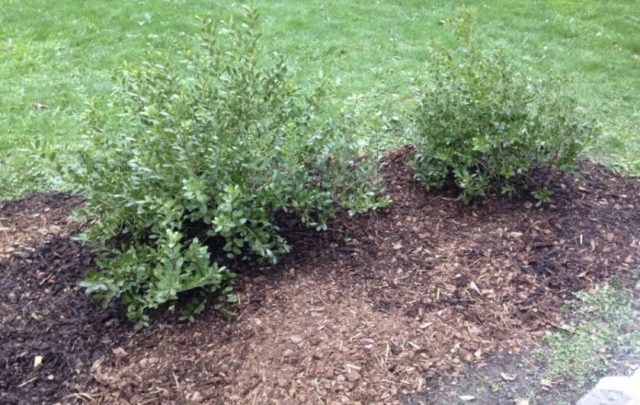Content
Honeysuckle, grown on a personal plot, bears healthy tasty fruits already in May. A properly rooted shrub will yield a good harvest in the second year. Agronomists recommend planting honeysuckle in spring. So the adaptation process will take place before the onset of frost, the tree will quickly take root and will not hurt.
Is it possible to plant honeysuckle in spring and summer
In spring, the shrub should be planted early, immediately after the snow melts. It is important to choose this particular period in order to prevent budding on the seedling. But this condition applies only to young specimens with an open root system.
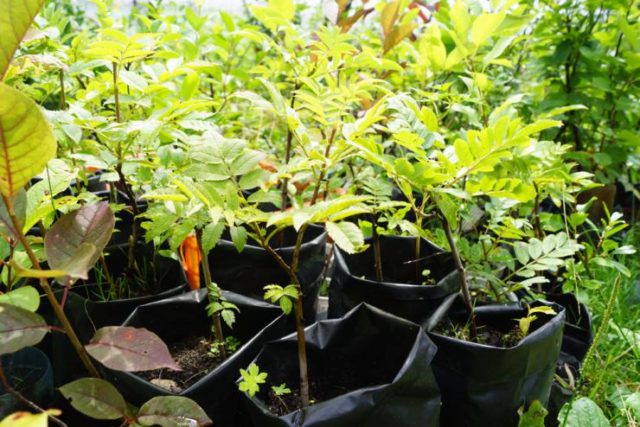
Seedlings with a closed root system will take well in the later period - in the summer
Honeysuckle with ZKS is possible during the entire growing season. The main thing is that the weather in spring is sunny and warm.
When to plant honeysuckle - fall or spring
Both seasons are favorable for the rooting of fruit shrubs. In the spring, you need to plant honeysuckle early enough before budding on the shoots. But during this period it may still be cold, and the culture will simply freeze. It is also recommended to plant honeysuckle in the spring in the southern regions of the country.
Autumn rooting of honeysuckle is considered more benign for it. When all biological processes of the plant are suspended, it is recommended to plant it before the onset of cold weather. This is done from early September to mid-October.
How to plant honeysuckle seedlings in spring and summer
In the spring, honeysuckle is planted with seedlings with a closed root system by the transshipment method. This means that all shoots on the rhizome and the ground around them must be preserved. So the honeysuckle will be well received and restored. This method is considered the most gentle. In addition, spring and summer are a favorable period for the high survival rate of seedlings.
Planting honeysuckle in spring from a container may carry some risks due to early bud break. It is recommended to root such a seedling before the beginning of May.
It is important to choose the right planting material.
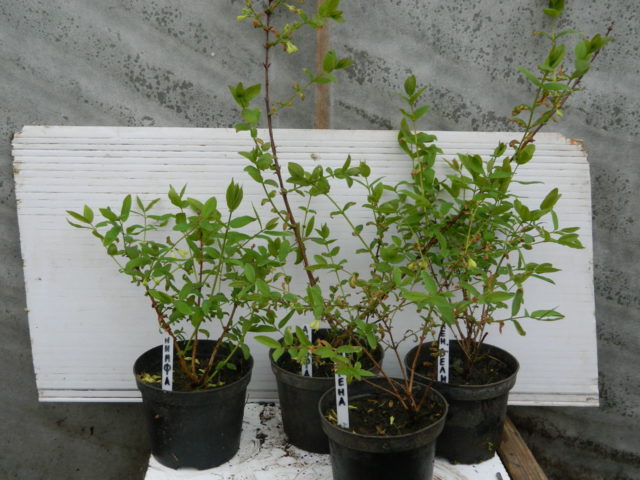
It is better to buy seedlings in special nurseries, where only varietal plants are located.
Their berries are sweeter; as a result of selection, scientists have eliminated the characteristic bitter taste of the fruit.
In spring, honeysuckle is planted with a height of at least 30 cm with a well-developed root system. 2-3 flexible branches, densely covered with leaves or buds, should depart from the trunk. There should be no dry spots, damage, pests on the tree.
Where to plant honeysuckle in spring and summer
For planting, choose an area that is well-lit by the sun or with a slight slope. Honeysuckle is planted in an elevated position, but not in a low area.
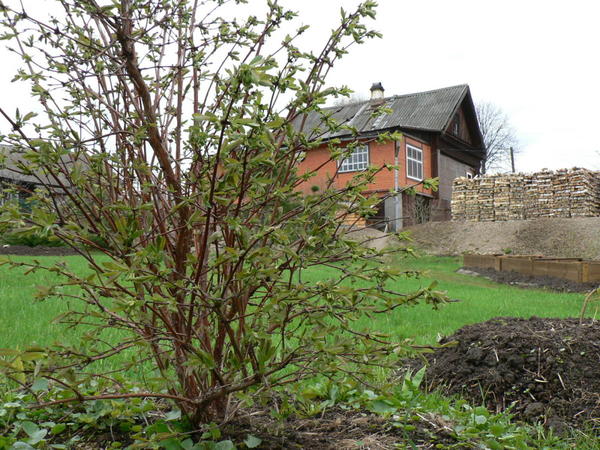
The plant will tolerate a small partial shade
You cannot plant honeysuckle near tall trees and buildings - in the shade, the culture does not bloom well and practically does not bear fruit
Honeysuckle is planted in fertile soil; loamy or sandy loam soil is also suitable.There should not be an overabundance of soil components: the clay is heavy, moisture stagnates, the root of the plant will quickly rot. In sandy soil there is a rapid evaporation of water, the plant is constantly experiencing a lack of it.
Honeysuckle is unpretentious, but shrubs should not be planted in swampy areas, in places where there is a close occurrence of groundwater.
Also, adult shrubs get sick less when transplanted and take root faster.
Landing site preparation
A week before the honeysuckle is planted, a summer cottage is prepared. First of all, they get rid of weeds, perennials are especially carefully removed. After that, the soil is dug up and crumbled so that not a single root remains.
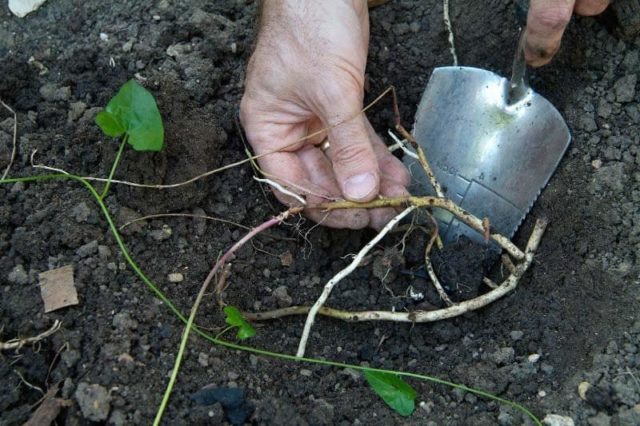
Weeds, especially wheatgrass, can weaken a seedling
If the soil is highly acidic, chalk or dolomite flour is added to it. A month before the intended planting, lime is introduced into the land with a high acidity - 200 g per 1 sq. m.
Organic fertilizers will help to increase soil fertility. They are brought in if the site has not been fertilized since the fall.
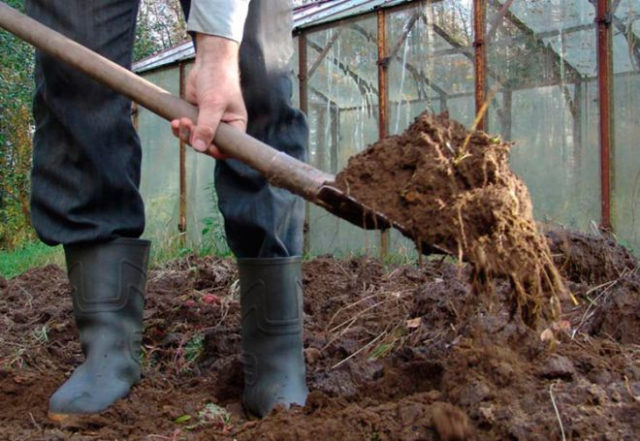
It is optimal to dig up the soil with manure or humus a week before planting when preparing the holes
Then mark the landing site. Honeysuckle is recommended to plant several units at the same time: it is a self-fertile plant, and it requires pollinators. When planting tall varieties, indents are made by 3 m, for medium ones - 2.5 m, undersized ones are planted every 1.5 m.The distance between the rows should be at least 3 m.
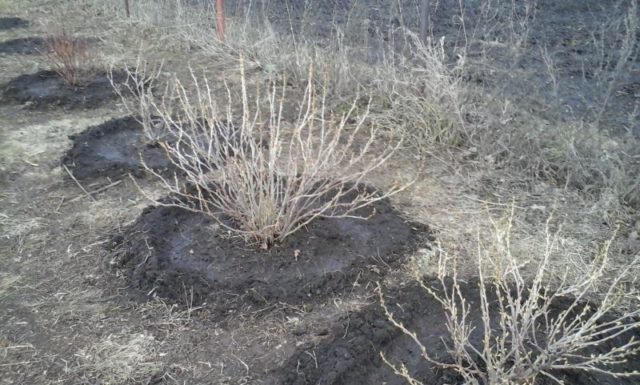
It is important to observe this layout, since honeysuckle grows rapidly, forming a lush crown, but at the same time its branches are quite fragile, easily deformed and broken.
It is important to observe this layout, since honeysuckle grows rapidly, forming a lush crown, but at the same time its branches are quite fragile, easily deformed and broken.
How to properly plant a honeysuckle seedling in spring and summer
The size of the planting pit depends on the volume of the rhizome of the shrub. Honeysuckle should be planted in holes, the diameter of which is about half a meter, and the depth is at least 40 cm.

Several bushes are rooted in trenches, keeping distance and taking into account the depth
Sequencing:
- The preparation of the pit for planting honeysuckle in the spring begins with the lining of the drainage layer.
For him, take one of the proposed materials: expanded clay, crushed stone or broken brick
- On top of the drainage, a hill is poured, consisting of a prepared soil mixture: 2 buckets of humus and an upper layer of earth each, superphosphate (2 tbsp. L.), Ash (1 kg).
The filler should occupy at least 2/3 of the planting hole volume
- Immediately before planting in the spring, seedlings with an open root system are carefully examined. The branches are slightly shortened, if there are dry processes, it is better not to touch the root, it is important to keep all its processes intact.
- The rhizome is soaked for half an hour in the ground, diluted with water, until the consistency of liquid sour cream.
You can add a little clay, such a simple talker will prepare the root for planting
- After the specified time, the tree is planted strictly vertically in the hole.
The root processes are straightened, laid out around the circumference of the earthen hill
- The root is covered with soil mixture, it is slightly trampled. The root collar should be at ground level or 0.5 cm above it.
- The shrub is quickly adopted; it is not recommended to prune its branches after planting, as in other fruit plants.
- Earth is poured around the seedling in a circle, forming a watering roller.
This is necessary so that the water goes under the root, and does not spread over the site.
- Honeysuckle in the spring after planting is watered with several buckets of water.
After the liquid is absorbed, the trunk circle is covered with mulch.
Sawdust, peat, wood chips, hay can be used as mulch.
This procedure will prevent premature evaporation of moisture and cracking of the earth's surface.
In this way, honeysuckle is planted with a closed and open root system. The shrub tolerates any agrotechnical procedures well.
In the process of planting honeysuckle in April, the following nuances are taken into account:
- The rhizome of the plant is carefully freed from the film or container; it is important not to damage a single process.
- The root of such a seedling is not cut or soaked in chemical solutions before planting.
- The plant is lowered into the hole along with an earthen lump.
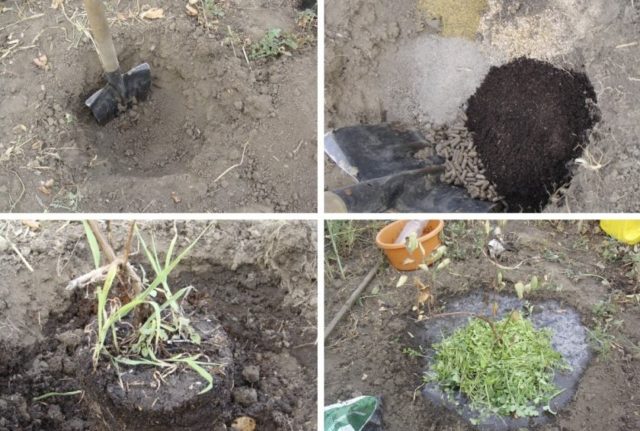
The root of the goals, the faster the shrub will take root.
A seedling of this type is not pruned either before or after planting. At first, until complete rooting occurs, it must be shaded, protected from direct sunlight.
Honeysuckle care in spring and summer
Weeding begins in early spring. Remove all weeds around the bush. The ground near the trunk circle should be light and fluffy.
Before budding, in the spring, sanitary pruning of the shrub is carried out.
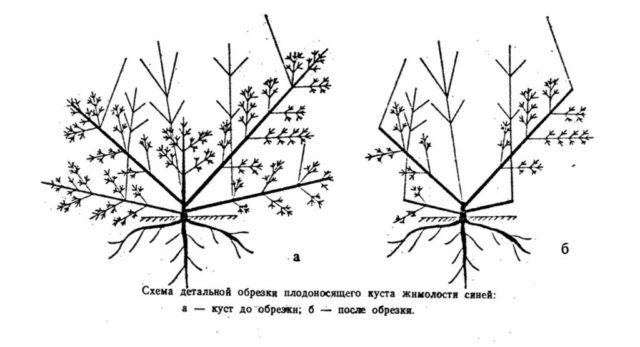
Removes outgrowths damaged during the winter
If the summer is dry, the honeysuckle is watered regularly. For one plant, 1-2 buckets of water are allocated.
If, before planting, fertilizers were laid in the hole, they are not used for the next year or 2. In the subsequent time, nutrient mixtures will need to be added.
Top dressing begins in early April, in time the process should coincide with the period of budding.
Ingredients are taken on a bucket of water: 1 tbsp. l. urea and nitrate, ammonium sulfate (2 tbsp. l.) They are dissolved in 15 liters of warm liquid and poured under a honeysuckle bush. This fertilizer is applied immediately after harvest.

If the soil is not fertile, such dressing is reintroduced with the onset of leaf fall in the fruit plant.
In the spring, in the process of intensive plant growth, nitrogen fertilization is used. They can be organic or mineral.

As soon as the crop is harvested in May, it is better to use potash or phosphorus fertilizers.
They will strengthen the culture, but will not provoke fruiting or growth. So the plant will safely go to winter at the end of autumn.
It is important not to forget about watering in spring and summer. The procedure is carried out 2 times a week. For each bush planted, you will need at least 2 buckets of water.
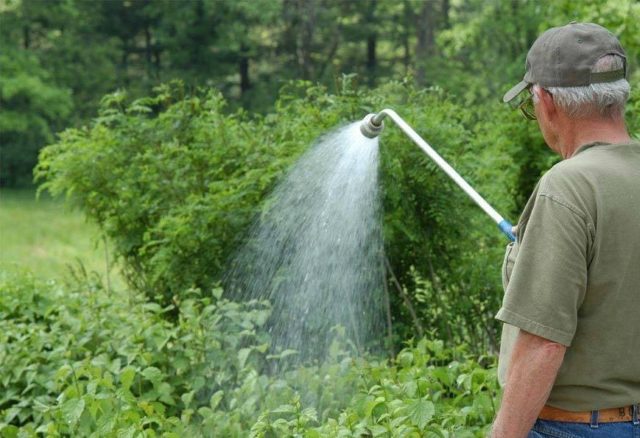
Especially intensively moisturize honeysuckle during fruiting
Lack of moisture will negatively affect the number and size of berries. Their taste is directly dependent on the abundance of water.
If the season is dry, be sure to moisten the trunk circle every 10 days. The liquid must penetrate into the soil to a depth of 30 or 40 cm.
In summer, before and after watering, the soil in the area of the trunk circle is loosened.
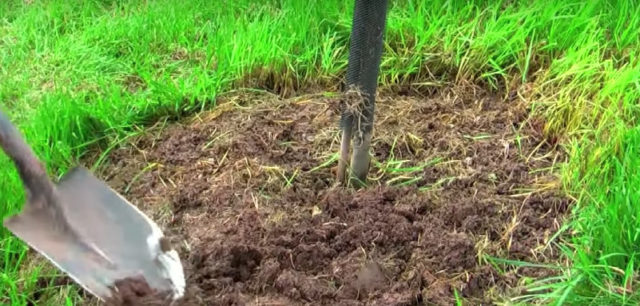
Loosening is carried out carefully so as not to damage the shoots of the rhizome located close to the surface of the earth
If the soil is mulched, the cover is regularly renewed to avoid root rot.
If the near-trunk circle is covered with a lawn, it is mowed.

The growth of grass near the trunk must not be allowed
This has a bad effect on the development of shrubs, excess vegetation becomes a bait for harmful insects.
The shrub is treated for pests in early spring. It is important to complete all manipulations where chemicals are used before the ovaries appear.
After harvesting (mid or late May), you can start killing harmful insects and diseases.

Most often, honeysuckle attacks aphids
New generation insecticides are used against the pest. They will not harm the tree and relieve it of insect attacks.
In the spring, it is important to treat the shrub with Bordeaux liquid.
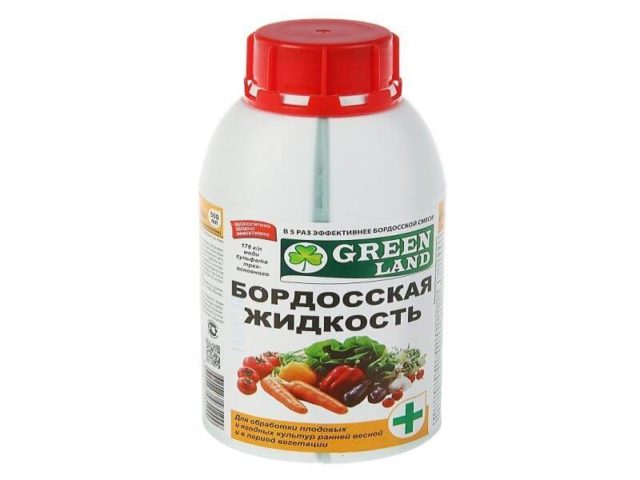
The tool effectively fights against all fungal diseases of fruit crops
If the spring processing is missed, it is mandatory to carry out after harvesting, while using a 1% solution of Bordeaux liquid.

In this case, the treatment with fungicides in the spring is carried out without waiting for the harvest.
At the end of August, honeysuckle leaves fall. At this time, they begin to trim. Remove dry, damaged branches. If the culture is less than 5 years old, pruning is done to a minimum.
Old honeysuckle bushes need thinning of the branches. It is especially important to remove those that grow into the crown. Lignified branches, on which there are no young shoots, and in the spring there were no ovaries, are cut off almost to the base.
If the weather is warm after leaf fall in August, honeysuckle may bloom again.
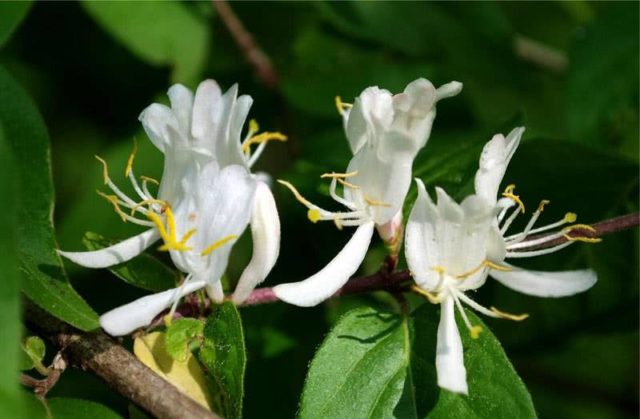
These buds are immediately cut off to stop all biological processes, to prepare the plant for the coming cold weather and wintering.
Conclusion
Gardeners advise planting honeysuckle in the spring. It is important to choose a warm, sunny day in April to root the seedling. A later planting is not recommended, as the honeysuckle will release its buds, after which it will start to hurt, it may not be accepted. For planting, choose a shrub at least 2 years old. Such a tree will well survive the transfer to a new place. Honeysuckle is unpretentious. Regular care for the growth and abundant fruiting of the crop is just as important as a carefully selected variety and well-prepared soil.
